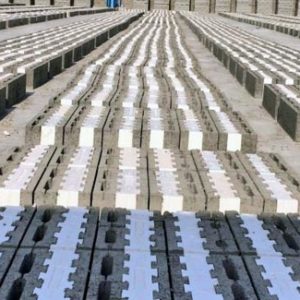It is a factory for manufacturing interlocking tiles, which are a type of tiles in the form of geometric shapes made of chemically treated concrete.

“The project involves establishing a factory for manufacturing interlocking paving tiles, which are a type of paving made from geometrically shaped concrete treated chemically. It is installed using an interlocking method, where the concrete tiles are laid without the use of cement mortar, directly on compacted sand. The reason for this is their interlocking connection, which relies on their weight for stability and prevents movement. The tiles fit together, allowing them to be removed and reinstalled when needed for digging beneath them, without being damaged or broken. They are manufactured in various shapes and colors and are used for paving walkways, roads, parking lots, gas stations, resorts, and tourist villages. Their ability to withstand high pressure and loads, along with their strong resistance to wear, makes them suitable for standard applications like airports and fuel stations. The key feature of interlocking tiles is their wide variety of shapes, offering an opportunity for creativity in floor design.”



Here’s the translation of your text
“Reducing the market gap for cement products
Creating new investment opportunities with good returns
Achieving a good return for the project owner
Employing the workforce and improving their economic and social status
Achieving good returns and cash flows, with added economic value
Using the latest manufacturing technologies for cement products
Executive summary
Study project services/products
Market Size Analysis
Risk Assessment
Technical study
Financial study
Organizational and administrative study

Given the importance of the sector, “Mashroo3k” presents below the key performance indicators of the construction and building sector in the Gulf Cooperation Council (GCC) countries:
The Gross Domestic Product (GDP) of the construction and building sector: SAR 168.75 billion
Sector’s contribution to GDP: 4.66%
Number of companies operating in the sector: 148,026
Number of employees in the sector: 3,541,977
Value of projects implemented in the sector (according to the latest statistics): SAR 311.56 billion
Saudi Arabia ranks first in the region as the largest construction market, with an annual value exceeding USD 100 billion
GDP of the construction and building sector: AED 123.95 billion
Sector’s contribution to GDP: 8.3%
Number of companies operating in the sector: 42,428
Number of employees in the sector: 1,564,095
GDP of the construction and building sector: BHD 936.79 million
Sector’s contribution to GDP: 7.7%
In 2016, the sector’s value did not exceed BHD 857 million, but it has since increased over a few years to reach BHD 945.51 million
GDP of the construction sector: OMR 1.943 billion
Sector’s contribution to GDP: 6.7%
Number of employees in the sector: 548,999
The construction sector accounts for the highest percentage of Omani workers in both public and private sectors (22.4%), and 29.6% of the total expatriate workforce in the country
GDP of the construction and building sector: KWD 838.9 million
Sector’s contribution to GDP: 2.14%
Number of companies operating in the sector: 1,502
Number of employees in the sector: 187,705
GDP of the construction and building sector: QAR 81.22 billion
Sector’s contribution to GDP: 12.1%
Number of companies in the sector: 5,629
Number of employees: 840,999
The construction and building sector accounts for over 40% of Qatar’s economically active adult population
The construction and building sector is one of the most promising sectors in the region. There is no doubt that investing in its activities will be highly rewarding in the future. The increasing population and the ongoing improvement of infrastructure across the GCC will make this sector a prime destination for investors and entrepreneurs seeking high returns with minimal hassle.
Experts expect the market to grow at a rate of 4.2% over the next three years, with market value projected to reach USD 10.5 trillion by 2023.
In 2020, the global construction output was estimated at around USD 10.7 trillion, and it is expected to grow by 42% (an increase of USD 4.5 trillion) between 2020 and 2030, reaching USD 15.2 trillion by the end of the decade.

The construction and building sector contributes approximately 13% to the global Gross Domestic Product (GDP), and this share is expected to increase to 13.5% by 2030.
According to the available statistics, infrastructure is projected to top the list of the fastest-growing subsectors within the construction and building industry, with an estimated growth rate of 4% during the period from 2020 to 2030.